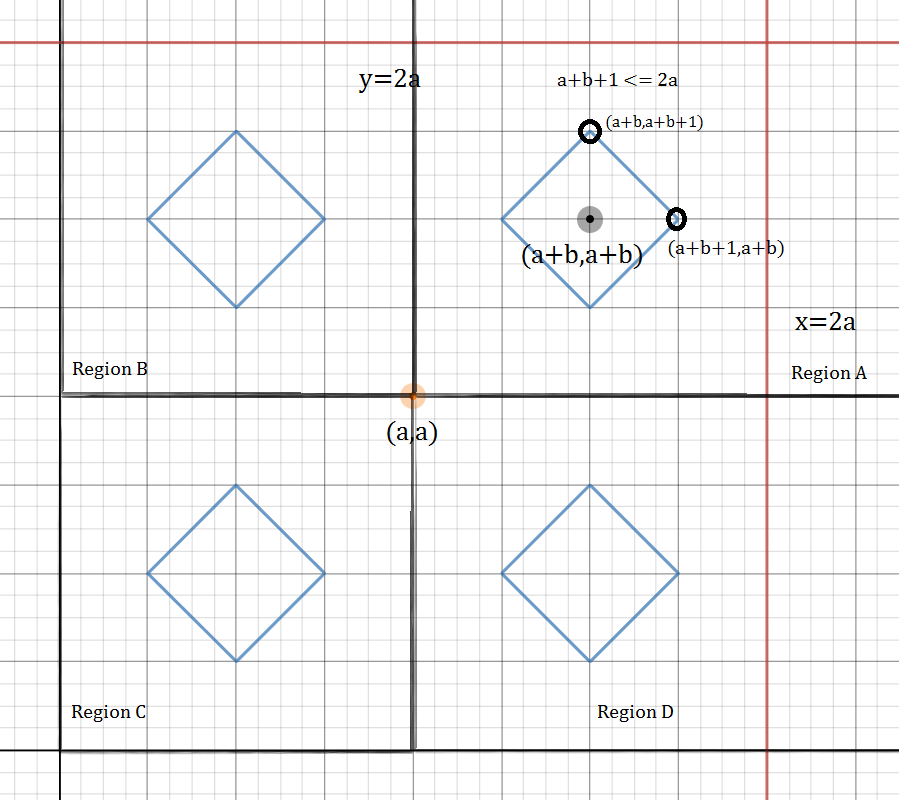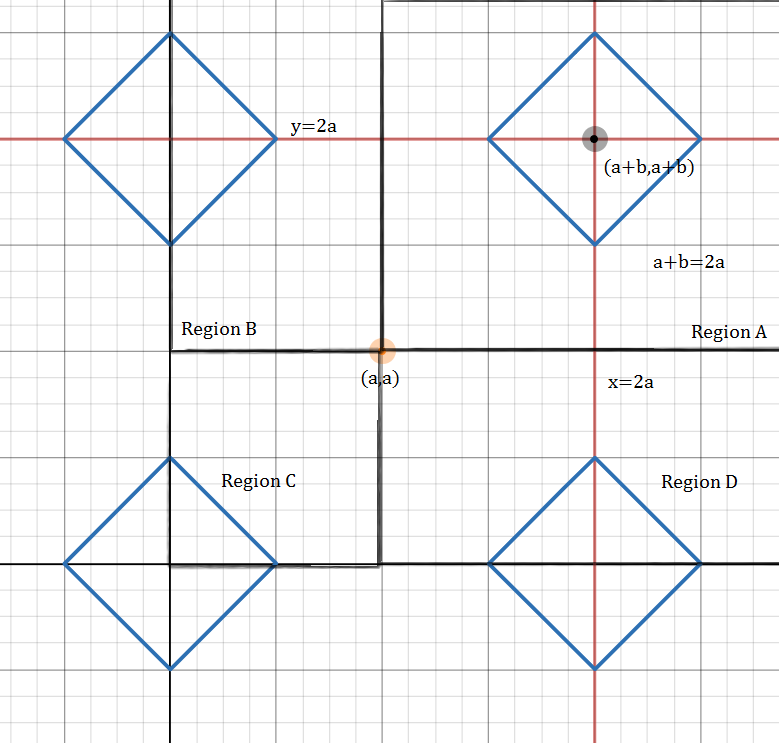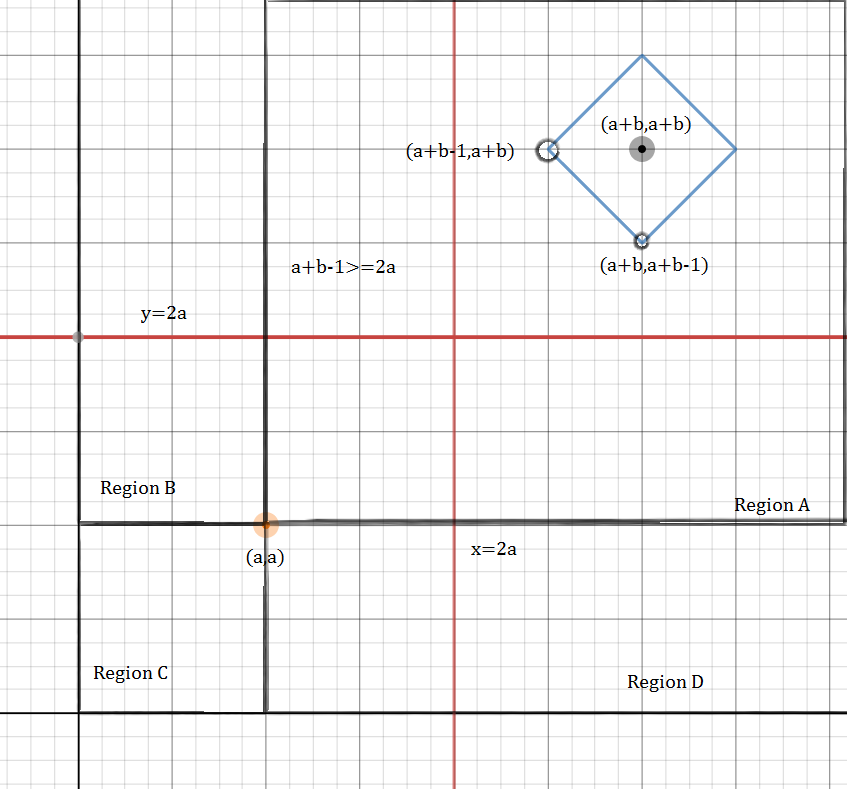Seriously, Who Developed The Mod Function?
The length of the graph of can take possible values for positive integers and . Let the sum of all these values be .
Find the value of .
The answer is 39.
This section requires Javascript.
You are seeing this because something didn't load right. We suggest you, (a) try
refreshing the page, (b) enabling javascript if it is disabled on your browser and,
finally, (c)
loading the
non-javascript version of this page
. We're sorry about the hassle.
Relevant wiki: Absolute Value Problem Solving - Intermediate
Substituting x by − x returns the same equation. Similarly substituting y by − y also returns the same equation. Therefore the graph represented by this equation is symmetrical about both the x and y axes and the length of the graph in all the quadrants is the same.
∴ The length of graph = 4 × the length of graph in the first quadrant.
In the first quadrant, x > 0 and y > 0 , ∴ the equation reduces to ∣ ∣ x − a ∣ − b ∣ + ∣ ∣ y − a ∣ − b ∣ = 1
Now, if we shift the origin to ( a , a ) , the equation becomes ∣ ∣ x ∣ − b ∣ + ∣ ∣ y ∣ − b ∣ = 1 , which is again symmetrical about both the axes. Therefore, the graph in the first quadrant can further be divided into 4 symmetric regions by the lines x = a and y = a :
Region A a ⩽ x , a ⩽ y
Region B 0 ⩽ x ⩽ a , a ⩽ y
Region C 0 ⩽ x ⩽ a , 0 ⩽ y ⩽ a
Region D a ⩽ x , 0 ⩽ y ⩽ a
Now, in the region A, a ⩽ x , a ⩽ y , therefore the equation becomes ∣ x − ( a + b ) ∣ + ∣ y − ( a + b ) ∣ = 1 whose graph is a square congruent to ∣ x ∣ + ∣ y ∣ = 1 but centered at ( a + b , a + b and has side 2 and vertices ( a + b , a + b + 1 ) , ( a + b , a + b − 1 ) , ( a + b + 1 , a + b ) and ( a + b − 1 , a + b ) . Maximum x-coordinate(and also y) of the square = a + b + 1 , Minimum x-coordinate(and also y) of the square = a + b − 1 .
If any portion of the graph in the region A lies outside the region x ⩽ 2 a , y ⩽ 2 a then its reflection in the regions B,C or D might not completely lie in the first quadrant. Therefore, there can be 3 cases :
1- The square completely lies inside x ⩽ 2 a , y ⩽ 2 a , i.e. all corners of the square are on or inside x = 2 a or y = 2 a or a + b + 1 ⩽ 2 a (Max x and y coordinate of the square are less than 2 a .)
Then the graphs in regions B, C and D will be congruent to the graph in the region A.
∴ The length of graph = 4 × the length of graph in the first quadrant.
= 4 2 × the length of graph in the region A = 4 2 × 4 × side of square ∣ x − ( a + b ) ∣ + ∣ y − ( a + b ) ∣ = 1 = 4 3 2 = 6 4 2 
2- The square partially lies inside x ⩽ 2 a , y ⩽ 2 a i.e. a + b − 1 ⩽ 2 a and a + b + 1 ⩾ 2 a or a + b = 2 a (Min x and y coordinate of the square are less than 2 a but max x and y coordinate of the square are greater than 2 a .)
Then only two sides of the square in region A will be reflected in region B and D and only one side will be reflected in region C.
∴ The length of graph = 4 × the length of graph in the first quadrant.
= 4 × ( 4 (no. of sides of square in region A) + 2 (in region B) + 1 (in region C) + 2 (in region C)) × side of square
= 3 6 2 
3- The square completely lies outside x ⩽ 2 a , y ⩽ 2 a , i.e. all corners of the square are on or outside x = 2 a or y = 2 a or a + b − 1 ⩾ 2 a (Min x and y coordinate of the square are greater than 2 a .)
Then no portion of the graph in region A will be reflected in region B, C or D.
∴ The length of graph = 4 × the length of graph in the first quadrant.
= 4 × the length of graph in the region A = 4 × 4 × side of square ∣ x − ( a + b ) ∣ + ∣ y − ( a + b ) ∣ = 1 = 4 2 2 = 1 6 2 
Thus the length of graph can take 3 different values , i.e. n = 3 .
S = Sum of all possible lengths = 6 4 2 + 3 6 2 + 1 6 2 = 1 1 6 2
Answer = n 2 S + 1
= 3 1 1 6 + 1 = 3 9